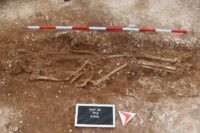 An excavation near the town of Marlow in southern England has unearthed the grave of an imposingly large and well-outfitted warrior from the 6th century. The grave was originally discovered by metal detectorist Sue Washington in March 2018. They began to unearth two round copper alloy vessels but stopped when they realized the objects were very old and fragile. They reported their discovery to the Berkshire Portable Antiquities Scheme and the Finds Liaison Officer excavated the find site.
An excavation near the town of Marlow in southern England has unearthed the grave of an imposingly large and well-outfitted warrior from the 6th century. The grave was originally discovered by metal detectorist Sue Washington in March 2018. They began to unearth two round copper alloy vessels but stopped when they realized the objects were very old and fragile. They reported their discovery to the Berkshire Portable Antiquities Scheme and the Finds Liaison Officer excavated the find site.
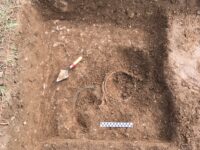 It was a targeted dig to carefully remove the two vessels the finders had uncovered. In the process, the archaeologist also found two spearheads buried in close proximity to each other, a larger one on top of a smaller. When one of the bowls was lifted, a single bone from a toe was found. The presence of human remains and the objects recovered indicated this was an ancient grave. The bowls and spearheads were recovered for conservation and the site reburied for later exploration.
It was a targeted dig to carefully remove the two vessels the finders had uncovered. In the process, the archaeologist also found two spearheads buried in close proximity to each other, a larger one on top of a smaller. When one of the bowls was lifted, a single bone from a toe was found. The presence of human remains and the objects recovered indicated this was an ancient grave. The bowls and spearheads were recovered for conservation and the site reburied for later exploration.
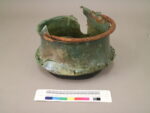 One of the vessels is a hanging bowl or bucket of the Gotlankessel type, characterized by its rounded, almost spherical shape and the triangular lugs that connect the curved iron handle to the rim of the bowl. It is undecorated. These types of vessels are believed to have been produced by workshops in the Namur region of modern-day Belgium. They date from the late 5th century through the 6th century.
One of the vessels is a hanging bowl or bucket of the Gotlankessel type, characterized by its rounded, almost spherical shape and the triangular lugs that connect the curved iron handle to the rim of the bowl. It is undecorated. These types of vessels are believed to have been produced by workshops in the Namur region of modern-day Belgium. They date from the late 5th century through the 6th century.
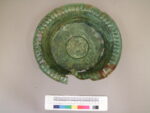 The other is a flanged bowl with repoussé decoration around the flanged edge. This kind of decoration is typical of Late Roman designs but the bowl itself is likely an early medieval object inspired by Roman work. It dates to the first quarter of the 6th century.
The other is a flanged bowl with repoussé decoration around the flanged edge. This kind of decoration is typical of Late Roman designs but the bowl itself is likely an early medieval object inspired by Roman work. It dates to the first quarter of the 6th century.
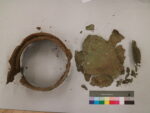 Both vessels were heavily damaged by agricultural activity. Much of the flange of the bowl was in pieces and the foot ring was detached leaving a hole in the bottom. The hanging bucket is missing one of its lugs and its base was crumpled and fragmentary. Had the finders attempted to pull them out on their own, without question they would have caused irreparable damage to the fragile assemblage. Because
Both vessels were heavily damaged by agricultural activity. Much of the flange of the bowl was in pieces and the foot ring was detached leaving a hole in the bottom. The hanging bucket is missing one of its lugs and its base was crumpled and fragmentary. Had the finders attempted to pull them out on their own, without question they would have caused irreparable damage to the fragile assemblage. Because 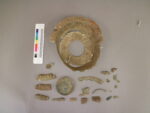 they were so responsible and the objects were professionally excavated, conservators were able to piece them back together and remove much of the corrosion. The bowl is almost complete now, with only a chunk missing from the flange. The cauldron is a little worse for wear than the bowl. There are holes where the base curves into the sides and a large gap on one side.
they were so responsible and the objects were professionally excavated, conservators were able to piece them back together and remove much of the corrosion. The bowl is almost complete now, with only a chunk missing from the flange. The cauldron is a little worse for wear than the bowl. There are holes where the base curves into the sides and a large gap on one side.
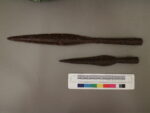 The two spearheads made it through the centuries remarkably well. They were heavily corroded when found, but thankfully most of the original metal was found intact when the corrosion products were removed. Their styles date them to early Post-Roman period, around 450-550 A.D.
The two spearheads made it through the centuries remarkably well. They were heavily corroded when found, but thankfully most of the original metal was found intact when the corrosion products were removed. Their styles date them to early Post-Roman period, around 450-550 A.D.
This August, archaeologists from the University of Reading and a team of volunteers did the first thorough survey and excavation of the find site.  They found additional luxury objects including glass vessels, garment fittings and shears, and the full skeleton of the man who owned all those grave goods. He was buried with his sword still in its scabbard by his side, and it is in excellent condition. The scabbard is made of wood and leather and decorated with bronze fittings. It is one of the best preserved sheathed swords from this period ever found.
They found additional luxury objects including glass vessels, garment fittings and shears, and the full skeleton of the man who owned all those grave goods. He was buried with his sword still in its scabbard by his side, and it is in excellent condition. The scabbard is made of wood and leather and decorated with bronze fittings. It is one of the best preserved sheathed swords from this period ever found.
Dr Gabor Thomas, a specialist in early medieval archaeology at the University of Reading, said: “We had expected to find some kind of Anglo-Saxon burial, but what we found exceeded all our expectations and provides new insights into this stretch of the Thames in the decades after the collapse of the Roman administration in Britain.
“This the first burial of its kind found in the mid-Thames basin, which is often overlooked in favour of the Upper Thames and London. It suggests that the people living in this region may have been more important than historians previously suspected.
“This guy would have been tall and robust compared to other men at the time, and would have been an imposing figure even today. The nature of his burial and the site with views overlooking the Thames suggest he was a respected leader of a local tribe and had probably been a formidable warrior in his own right.”
The discovery of the Marlow Warlord may shed new light on a little-known period in the mid-Thames Valley. In the 6th century, this area was thought to be a borderland between the burgeoning tribal groups that would evolve into the Anglo-Saxon kingdoms of Wessex, Mercia and Kent. The presence of so important a figure may indicate there was a tribe here of significant local power that was later muscled out by or absorbed into the larger neighboring tribes that became kingdoms.
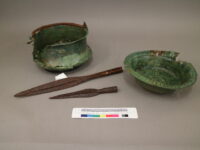 The remains of the Marlow Warlord will be studied further by University of Reading archaeologists in the hopes of learning more about the man — his age, where he was born and raised, what he ate, any health issues he may have had and how he died. The objects are still undergoing conservation. Sue Washington has donated the vessels and spearheads to the Buckinghamshire Museum in Aylesbury which plans to put them on display in 2021 when the museum reopens after renovation.
The remains of the Marlow Warlord will be studied further by University of Reading archaeologists in the hopes of learning more about the man — his age, where he was born and raised, what he ate, any health issues he may have had and how he died. The objects are still undergoing conservation. Sue Washington has donated the vessels and spearheads to the Buckinghamshire Museum in Aylesbury which plans to put them on display in 2021 when the museum reopens after renovation.